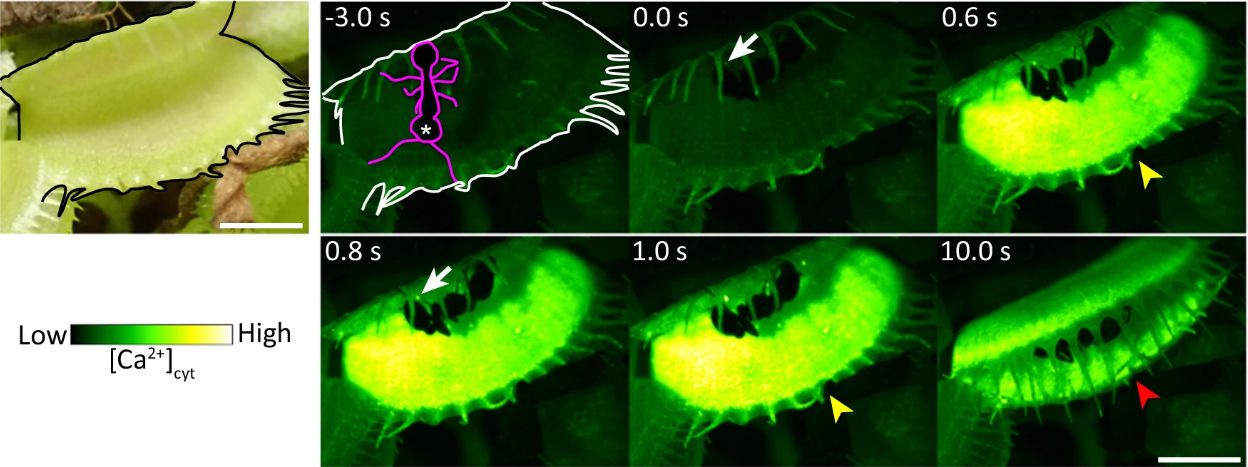Science
New Research Unveils Mechanosensor Behind Venus Flytrap’s Speed

Recent research has shed light on the remarkable speed at which the Venus flytrap (Dionaea muscipula) responds to stimuli. A study led by Hiraku Suda and colleagues, published in Nature Communications, identifies a mechanosensor known as DmMSL10 as critical to the rapid response of these fascinating carnivorous plants.
Understanding the Mechanism of Movement
Venus flytraps employ a spring-loaded trap mechanism to catch unsuspecting prey. While other carnivorous plants, such as the waterwheel plant (Aldrovanda vesiculosa), exhibit slower movement, the Venus flytrap’s ability to close its leaves in less than a second is particularly striking. The study confirms that the plant’s sensory hairs are finely tuned to detect specific stimuli, triggering a cascade of calcium signals that initiate the rapid closure of the trap.
Prior to this research, the exact mechanism behind this swift response remained largely a mystery. The team’s experimental approach involved breeding a variant of the Venus flytrap that lacked the DmMSL10 mechanosensor, allowing researchers to compare the responses of both the wild-type and knockout plants.
Key Findings on Calcium Signals
The research revealed that while both the wild-type and the knockout variants of the Venus flytrap experienced mechanical stimulation, the rate of action potential generation was significantly lower in the latter. The wild-type plants continued to generate action potentials even after stimulation ceased, illustrating the essential role of DmMSL10 in processing slight stimuli for prey detection. This was further corroborated through experiments where ants were allowed to wander on the leaves of both plant types.
In these tests, the wild-type Venus flytrap successfully captured the first ant that came into contact with its leaves. In stark contrast, the knockout variant failed to respond even after multiple ants interacted with it. This lack of movement indicated an insufficient calcium signal propagation in the knockout type.
The findings provide a clearer understanding of how D. muscipula and similar species generate long-range calcium signals, which are crucial for their feeding mechanisms. This research opens avenues for further exploration into how such mechanisms have evolved, potentially paralleling those observed in the animal kingdom.
With this advancement in knowledge, scientists are better equipped to investigate the evolutionary pathways that have led to the sophisticated predatory strategies found in carnivorous plants. As research continues, it may lead to insights not only into plant biology but also into broader biological principles shared across species.
-

 Business1 week ago
Business1 week agoIconic Sand Dollar Social Club Listed for $3 Million in Folly Beach
-

 Health1 week ago
Health1 week agoPeptilogics Secures $78 Million to Combat Prosthetic Joint Infections
-

 Politics1 week ago
Politics1 week agoAfghan Refugee Detained by ICE After Asylum Hearing in New York
-

 Science1 week ago
Science1 week agoResearchers Achieve Fastest Genome Sequencing in Under Four Hours
-

 Lifestyle1 week ago
Lifestyle1 week agoJump for Good: San Clemente Pier Fundraiser Allows Legal Leaps
-

 Health1 week ago
Health1 week agoResearcher Uncovers Zika Virus Pathway to Placenta Using Nanotubes
-

 World1 week ago
World1 week agoUS Passport Ranks Drop Out of Top 10 for First Time Ever
-

 World1 week ago
World1 week agoRegional Pilots’ Salaries Surge to Six Figures in 2025
-

 Entertainment1 week ago
Entertainment1 week agoJennifer Lopez Addresses A-Rod Split in Candid Interview
-

 Science1 week ago
Science1 week agoMars Observed: Detailed Imaging Reveals Dust Avalanche Dynamics
-

 Top Stories6 days ago
Top Stories6 days agoChicago Symphony Orchestra Dazzles with Berlioz Under Mäkelä
-

 World1 week ago
World1 week agoObama Foundation Highlights Challenges in Hungary and Poland









